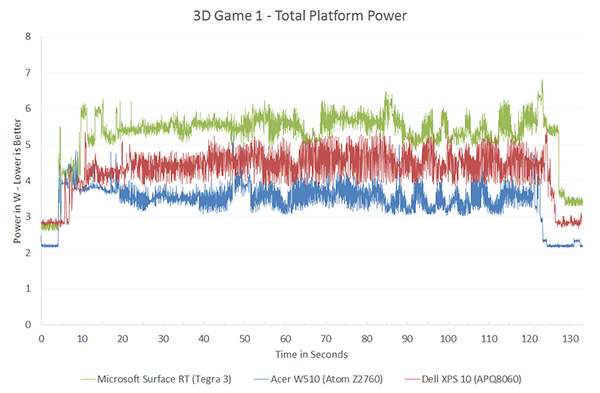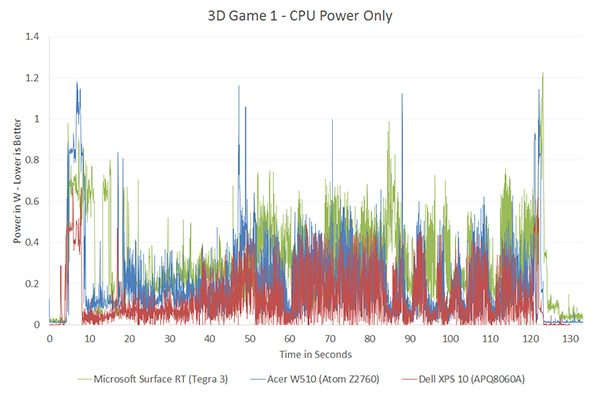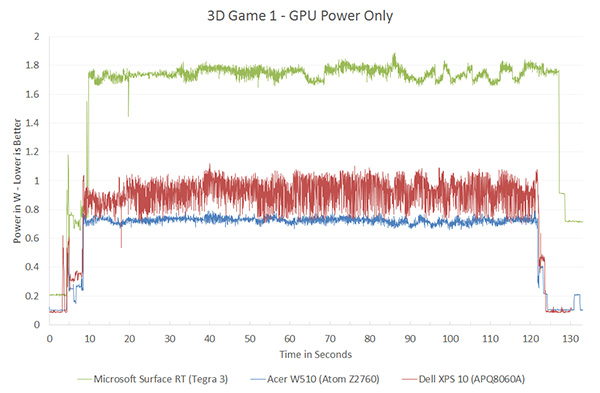The ARM vs x86 Wars Have Begun: In-Depth Power Analysis of Atom, Krait & Cortex A15
by Anand Lal Shimpi on January 4, 2013 7:32 AM EST- Posted in
- Tablets
- Intel
- Samsung
- Arm
- Cortex A15
- Smartphones
- Mobile
- SoCs
GPU Power Consumption - 3D Gaming Workload
While we don't yet have final GPU benchmarks under Windows RT/8 that we can share numbers from, the charts below show power consumption in the same DX title running through roughly the same play path. Tegra 3 remains the fastest in this test, followed by Adreno 225 and finally the PowerVR SGX 545/Atom solution. Power consumption roughly follows that same order, however Tegra 3 burns much more power in delivering that performance than either of the competitors. I'd be really interested to see how some of the higher performing Imagination cores do here.













140 Comments
View All Comments
kyuu - Friday, January 4, 2013 - link
You're the one stepping into the past with the CISC vs. RISC. x86 is not going to go away anytime soon. Keep dreaming, though.iwod - Saturday, January 5, 2013 - link
Nothing about Architectures in this comment, but by the time ARM Cortex A57 is out, so is Intel ValleyView, which doubles the performance. A57 is expected to give in best case scenario 30 - 50% increase in performance. And All of a sudden this look so similar to 2x Atom performance.It will only take one, just ONE mistake that ARM make for Intel to possibly wipe them off the map.
Although looking into the next 3 - 5 years ahead. It will be a bloody battle instead.
Cold Fussion - Friday, January 4, 2013 - link
Why didn't have any charts which were performance per watt or energy consumption vs performance in the GPU area? If the Mali chip is using twice the energy but giving 3x the performance then that is a very significant point thats being misrepresented.mrdude - Friday, January 4, 2013 - link
I was thinking the same thing.If I can game at native resolution on a Nexus 10 at better frame rates than on the Atom or Snapdragon SoC and the battery capacity is larger and the price of the device is equal, then do I really care about the battery life?
Although it's nice seeing Intel is getting x86 down to a competitive level with ARM, the most astonishing thing that I took away from that review was just how amazing that MaliT604 GPU is. All that performance and only that power draw? Yesplz :P
parkpy - Friday, January 4, 2013 - link
i've learned so much from AT's review of the iPhone5, Galaxy S III, and Nexus 4, and this article about mobile phones that it makes me wish AT could produce MORE reviews of mobile devices.All of this information is crack! I can't get enough of it. Keep up the good work! And Intel, I can't wait for you to get your baseband processor situation sorted out!
I was already tempted to get a Razr I, but it looks like before the end of the year consumers will have some very awesome technology in their phones that won't require as much time on the battery charger!
This Guy - Friday, January 4, 2013 - link
What if Rosepoint is software defined instead of fixed function?ddriver - Friday, January 4, 2013 - link
I am confused here - this review shows the atom to be somewhat faster than A15, while the review at phoronix shows the A15 destroying the atom, despite the fact intel's compiler is incredibly good at optimizations and incomparably more mature.So I am in a dilemma on who to trust - a website that is known to be generously sponsored by intel or a website that is heavily focused on open source.
What do you think?
kyuu - Friday, January 4, 2013 - link
Uh, did we read the same article? Where does it show the Atom being "somewhat faster than A15"? The article showed that the A15 is faster than Atom, but at a large power premium.ddriver - Friday, January 4, 2013 - link
On the charts I see the blue line ending its task first and taking less time, blue is atom, right?jwcalla - Friday, January 4, 2013 - link
A couple things:1) The Phoronix benchmarks were for different Atoms than the one used in this article. I don't know how they compare, but they're probably older models.
2) The Phoronix benchmarks used GCC 4.6 across the board. Yes, in general GCC will have better optimizations for x86, but we don't know anything (unless I missed it) about which compilers were used here. If this was an Intel sample sent to Anand, I'm sure they compiled the software stack with one of their own proprietary Intel compilers. Or perhaps it is the MS compiler, which no doubt has decades of x86 optimizations built in and probably less ARM work than GCC (for the RT comparison).
Don't take the benchmarks too seriously, especially since even the software isn't held constant here like it was in the Phoronix benchmarks. It's all ballpark information. Atom is competitive with ARMv7 architectures -- that's the takeaway.